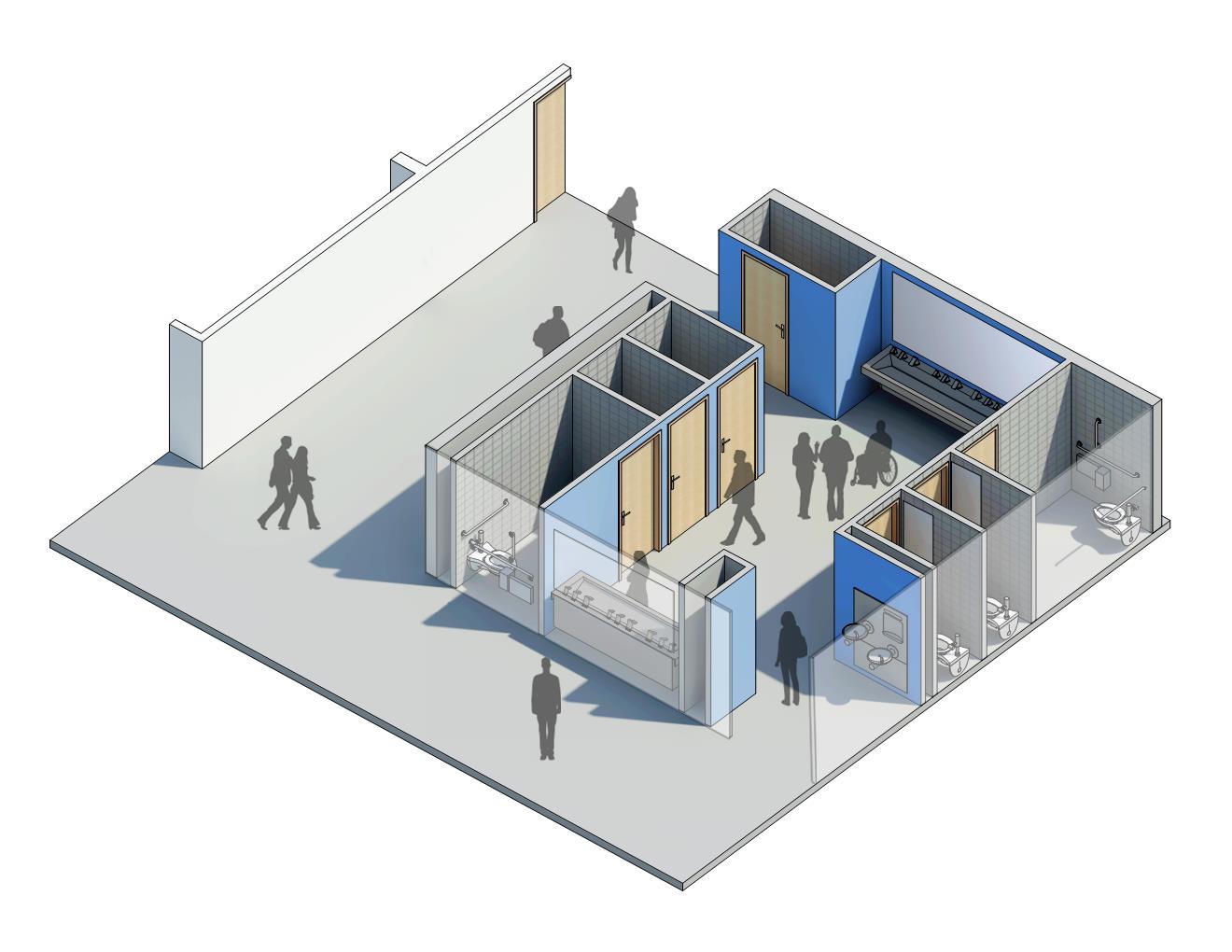
November 2, 2016
Why Architects Must Rethink Restroom Design in Schools
While the transgender movement may be currently illuminating the issue, toilet privacy is a basic human right that educational institutions can provide through thoughtful design.
Courtesy Benjamin Benschneider
Northwood Elementary School in the Mercer Island School District
‘Gang style’ bathrooms, in which rows of stalls are installed opposite rows of wash basins and designated only for males or for females, have been de rigueur in educational facilities for the last hundred years. They involve predictable plumbing, mechanical exhaust, and fixture costs. Short doors and divider walls allow for the passive monitoring of behavior.
Relinquishing this traditional bathroom model is daunting, since individual toilet rooms can significantly increase costs through additional plumbing, ductwork, ventilation, partitions, doors and hardware. These designs many times require additional space, trigger further ADA compliance, and invalidate some USGBC LEED points. Moreover, school districts typically have limited budgets, established facilities, and deep-rooted social practices.
Which is why the initiative shown by Grant High School in the Portland Public School District has been so extraordinary. In 2013, the school had 10 students who openly identified as transgender. To help combat the real possibility that they would drop out due to a perceived lack of safety, administrators designated four student bathrooms and two staff bathrooms—each individual rooms with a toilet, sink and mirror—as gender-inclusive. The bathrooms were immediately popular with all students at Grant HS, transgender or not, who enjoyed the privacy afforded by these enclosed facilities.
With a major renovation of the 1920s-era school on the horizon, the District realized that providing equitable toilet facilities for all 1700 students would be essential.
Architecture firm Mahlum’s design solution for Grant HS centered around replacing all existing ‘gang-style’ bathrooms with individual toilet rooms with full doors opening to a shared space for wash basins and drinking fountains. Urinals will not be installed. Two entrance and exit points eliminate the feeling of going into a ‘dead-end’ room, increasing safety and security. Signed with a simple pictorial representation of a toilet, not the ubiquitous ‘his’ (pants), ‘hers’ (skirt), or ‘their’ (both), the toilet room is open for use by all. When the renovation is complete in 2019, Grant HS will become the first in the District—and one of the few in the nation—to house one hundred percent inclusive bathrooms.

Courtesy Mahlum
Mahlum’s design solution for Grant High School in the Portland Public School District
For the new Northwood Elementary School in the Mercer Island School District, the same architectural team also abandoned gang style bathrooms, instead placing individual toilet rooms in many places on each floor. This solution boosts program flexibility and reduces time lost to toilet transitions. Since the District intends to keep the bathrooms unlocked and available to all students, the solution maximizes restroom equity, which is especially helpful for young students just learning to navigate social customs and keen to fit in with their peers.
Higher education institutions may more easily implement equitable bathroom designs because users are older, more diverse, and tend toward open-mindedness. For a new residence hall currently under construction at University of Oregon, Mahlum held student listening sessions, which revealed a strong desire for gender-inclusive living units with private bathrooms, as well as visibly inclusive public restrooms at the ground level and in common areas. However, residence facilities are still typically grouped by gender per floor or per community, and although suite-style bathrooms serving smaller clusters of students potentially mitigate gender-segregated restrooms, they can cost more. Like school districts, college and university administrators fear that enhanced design solutions will escalate costs, consume space, and drive up room rates.

Courtesy Mahlum
Inclusive restroom design at the University of Oregon
The desire to create more equitable restroom design can also be stymied by building codes that have not yet caught up to changing opinions. Local jurisdictions have limited legal authority to enact code changes, so they usually have no other recourse but to uphold strict compliance. As society calls for more equitable bathroom design, the design and construction industry must demand large-scale code changes to allow ‘alternate paths’ that comply with the intent of code and, moreover, serve the public good.
While the transgender movement (a phrase that actually encompasses the full LGBTQ community) may be currently illuminating the issue, toilet privacy affects a much broader group, including families with young children, adult caregivers, and people that are mobility-challenged or have health issues. Enhancing equity through privacy is a basic human right that primary, secondary and higher education institutions can uphold through thoughtful design solutions. By rethinking bathroom design in retrofits or new facilities, what was once an afterthought for architects can become a way to not just promote self-esteem, health and well-being, but improve safety and security.
As architects struggle with understanding what communities need and how to meet and overcome antiquated code regulations, we must quickly find a design vocabulary, inclusive of iconography and code guidelines, to reflect best practices. And most of all, we must place equity and human dignity at the center of these conversations.
JoAnn Hindmarsh Wilcox, AIA LEED AP, associate principal is the design lead for the education studio at Mahlum. JoAnn crafts nationally recognized buildings that prioritize student learning and support student life, rooted in a multi-platform, collaborative engagement process.
Kurt Haapala, AIA LEED AP, partner, is an industry leader in the planning and design of student life and housing facilities, and has helped build Mahlum’s higher education housing studio into a nationally recognized practice.
Recent Viewpoints
Viewpoints
Sustainability News Updates for Q2 2025





